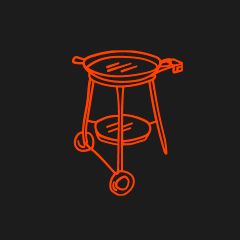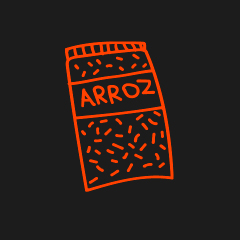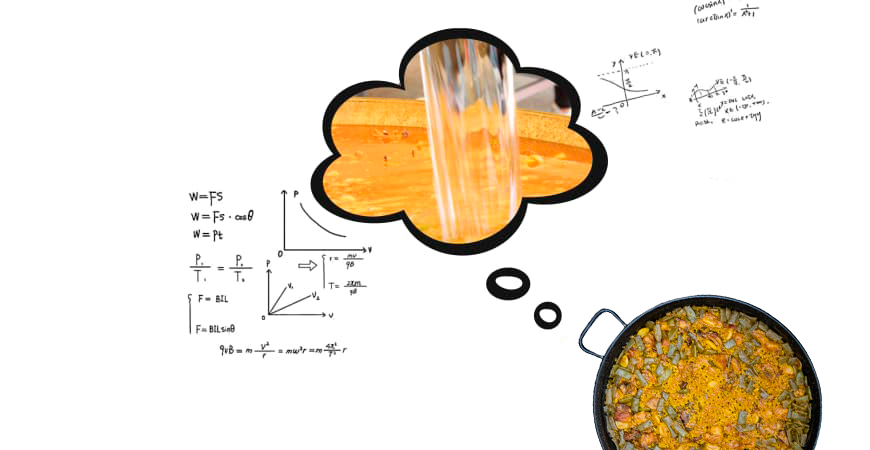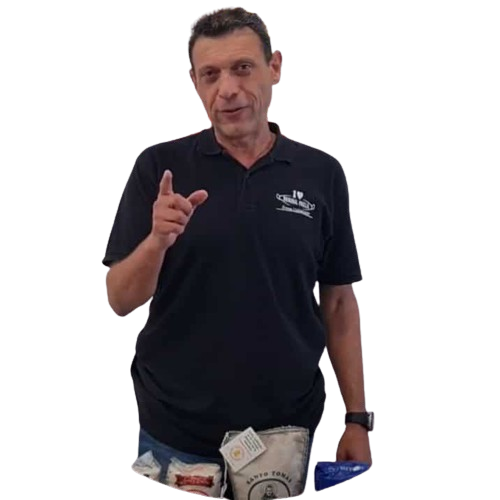How much water should I put in my paella?
This article is extremely complex due to the large number of variables involved in water consumption in paella. Keep in mind that the type of fire (gas or wood), the diameter of the paella pan, the thickness of the rice layer, the variety of rice used, the ambient temperature, and even altitude, along with many other factors, play an important role in calculating how much water to use in paella. For this reason, making an exact calculation of the necessary water is a very complex task, and we try to simplify it to the most important factors, meaning the calculation will never be 100% accurate.
Through this blog post, we aim to bring closer the vast knowledge and experience of many years from several expert rice chefs who have contributed to its writing. Among them, our technical team stands out, including the rice master Ascensión Casero and Carlos Gomez-Senent, creator of lapaella.net, cooking teacher, and executive chef in various establishments and rice restaurants in Valencia.
We hope that through this blog post, you will always be able to determine the amount of water you need for your paellas.
How much water should I use in my paella?
When preparing paella, there are many questions. How many servings? Meat, fish, vegetables? What variety of rice? How much rice will we need? All these questions have easy answers, but there is one that is constantly repeated.
How much water should I use in paella? This is a very important question because depending on the servings we want to make, we will need a certain amount of water. Also, the diameter of the paella pan changes the amount of water needed, and similarly, the fire's intensity can affect the required water for our paella. In this blog post, we give you the definitive answer to this question.
What is the ideal amount of rice per person?
When asked how many grams of rice per person for paella, based on our own experience, we recommend adding 100 grams of rice per person. Of course, this amount can vary for reasons such as whether you want to make a creamy or soupy rice, in which case you should use about 70 grams. You should also consider that if it's a main dish, you could use 125 grams. For this explanation, we will use the 100 grams per person guideline.
The reason why the amount of rice is important for measuring water is simple: part of the water evaporates when reducing the liquid to make the broth, and another part is absorbed by the rice during cooking. Therefore, it is necessary to know how much rice we are going to use in our paella.
Does the size of the paella pan and the type of vessel affect the amount of liquid?
The diameter of our paella pan also affects the amount of water needed, as it limits the capacity of liquid you can add to it, and depending on its size, it evaporates faster or slower. Here is a table of diameters based on the amount of water required.
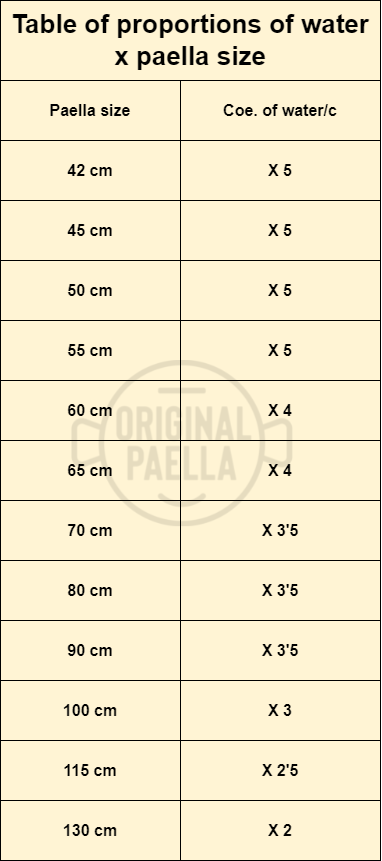
It must be noted that, before adding the rice to the paella, it is crucial to cook all the ingredients, whether vegetables or meats, for 5 to 10 minutes.
This period allows approximately 2 measures of water to evaporate out of the 5 initial ones, which is about 20% of the liquid. This is commonly recognized by the use of the paella fasteners, which, after being submerged in the broth, are almost completely uncovered. If you don't have fasteners, an effective way to recreate this effect is by using the paella magnet.
It is at this precise moment that the rice should be added. Start cooking over high heat and then reduce to medium heat.
It is essential to maintain this temperature so that the first half of the cooking progresses gradually, and the rice remains invisible until approximately 10 minutes have passed from the start of the cooking. Then, lower the heat to the lowest possible setting and continue until the cooking is complete.
The reason we use these measures is because of what the expert rice chefs call Q1 and Q2.
Q1 refers to the remaining amount of water, now turned into broth, that we will use when adding the rice.
Meanwhile, Q2 refers to the amount of water we have before adding the rice, part of this water will evaporate while preparing the broth.
What is the water-to-rice ratio in paella based on the variety of rice?
The amount of broth required to make a paella can vary depending on the variety of rice used.
Some varieties of rice absorb more liquid than others, so it is important to know what variety of rice we are using. Older rice, regardless of the variety, will absorb more liquid.
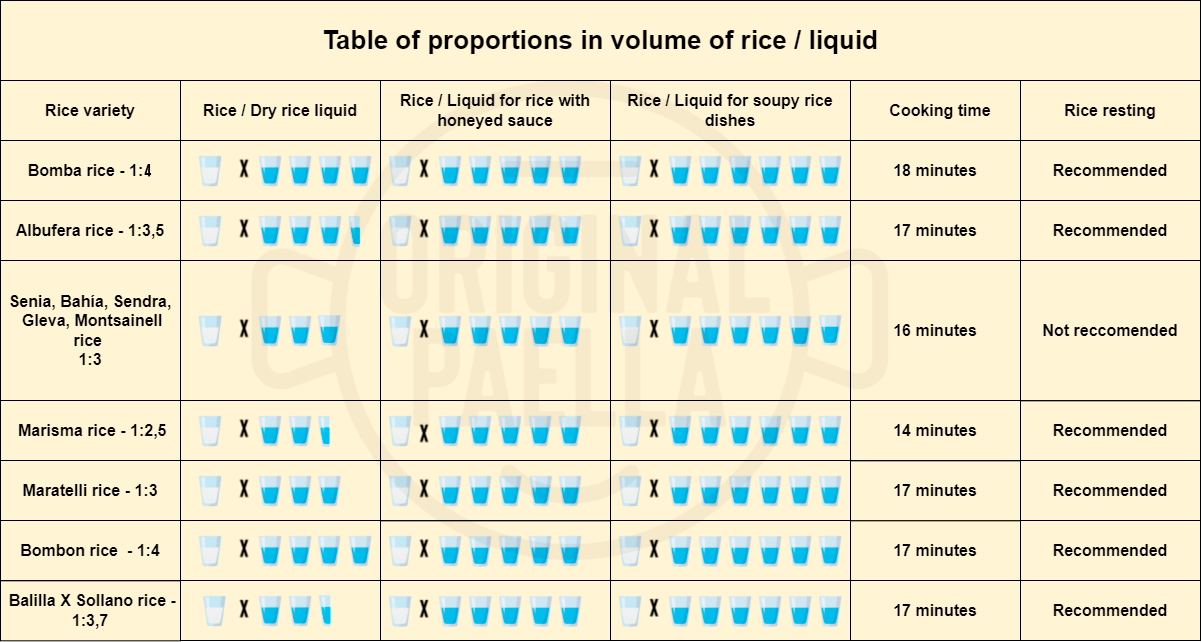
We should keep in mind that this table shows the volume of rice/liquid used to prepare dry rice dishes, that is, a thin or Valencian paella. Larger quantities will require minor adjustments.
Frequently Asked Questions about the amount of water in paella
What water proportion would I need if I make a baked rice?
The proportions needed for making baked rice can vary depending on the vessel and oven temperature, whether it's gas, wood, or steam. Depending on the vessel, the rice-to-water ratio can vary as long as cold broth is added, but it is not affected if boiling broth is used. The broth measurements would be:
1 serving - 1:3 in aluminum containers.
1 serving - 1:2.5 in clay, stoneware, or porcelain containers.
From 4 servings onwards: 1:2 or 1:1.7 depending on your container. We also include certain vegetables like peppers or pumpkins as containers.
When making 4 servings, the rice and water parameters stabilize, as long as the container used has the same height. This is because, although you can increase the container size, raising its height will decrease the liquid ratio. Regarding the temperature required to make the recipe, we will continue using the same.
We emphasize that it is very important to preheat the oven to 220ºC and ensure the broth is boiling when adding the rice. From here, we add the rice and cook for 25 minutes at 200ºC, then lower the temperature to 180ºC and cook for another 15 minutes.
If using cold broth from the start, it will take longer to heat, so we will need slightly less broth.
Can the texture of the broths/fumets or water hardness affect my paella?
When we talk about texture in this context, we refer to reduced broths, which are thicker and have a high collagen, protein, and fat content.
It should be noted that a different texture in our broth does affect our paella because, although it may not seem so, the type of rice we are trying to make has different textures depending on its variety, and this happens because different ways of preparing the recipe aim to use different broths.
A soupy rice results in the rice with the highest amount of broth per rice of all the variants, and the broth tends to be tastier because it is an essential part of the dish.
Meanwhile, a creamy rice stands out for having a thick broth, which becomes part of the rice itself, because the rice is bound by the starch or fats in the broth.
On the other hand, a dry rice almost completely lacks moisture, and its proper point can be achieved through an emulsion, which is a homogeneous mixture of two liquids, in our case, water and oil from the broth.
We caution that if our broth has a high level of collagen, it is recommended to add 20% more, but we should keep in mind that it will take longer to cook.
Interestingly, we have heard people believe that the hardness of the water affects the flavor and texture of the paella, but both we and many others can say that this is just a myth, with no scientific basis to prove that the hardness of the water offers any benefits to the paella.

Can the power of the fire affect the amount of water?
Different types of fire can affect the amount of water required for making our paella.
If we use butane or propane, we have the advantage of easily controlling the fire's intensity during the recipe processes. This is a great advantage because using too much power will end up evaporating a greater amount of liquid, meaning that poor control of the power could result in evaporating more liquid than desired.
In the case of using firewood or vine shoots, we will need to use more water than usual, because the water will evaporate faster as we don’t have full control over the fire's power, since this fire has a higher calorific power than if we were using gas. We should note that this doesn’t mean the proportion of liquid needed for cooking the rice has changed; this proportion will remain the same.
Lastly, in the case of using a conventional oven, the amount of liquid will be lower, because the oven’s power is lower than the other two options, which means that a higher amount of water would take too long to evaporate or be absorbed by the rice and its ingredients.
Does the weather or the environment affect my paella?
Although this question may sound unexpected, the reality is that the environment where the paella is being prepared can affect its cooking, although it should be noted that it doesn’t significantly affect it.
If the environment is humid, the broth will evaporate less. If the environment is dry, the evaporation of the broth will be higher.
The real factor where the environment affects paella cooking is in altitude. As we explained in a previous blog post, the altitude where the paella is cooked can modify the cooking time.
The lower the atmospheric pressure (which decreases as altitude increases), the lower the boiling point of water will be, as its molecules, being less pressed, find it easier to move and shift, and as a result, the boiling temperature decreases.
Because of this, at 1,000 meters above sea level, the water takes longer to begin boiling, and it boils at 97ºC instead of the usual 100ºC.
Since the boiling temperature is lower, the rice takes a few more minutes to cook, which means more evaporation. In short, at higher altitudes, you need to use more liquid and increase the cooking time of the rice by a few minutes.
What if I add ingredients with high water content or another liquid?
If we add ingredients with a high water content to our paella, we must keep in mind that this will also affect the amount of water needed, so we should evaporate the moisture from the chosen ingredients properly.
The best way to remove this extra liquid is through the sofrito.
If we use wines or juices, we should subtract that amount of liquid from the total liquid we are going to use in our recipe, otherwise, we would be using more liquid than desired or recommended.
We hope this blog post helps answer your questions about how much rice and water is needed for paella and rice dishes. Don’t forget to visit the rest of our blog to find more guides and recipes, rice lovers!

